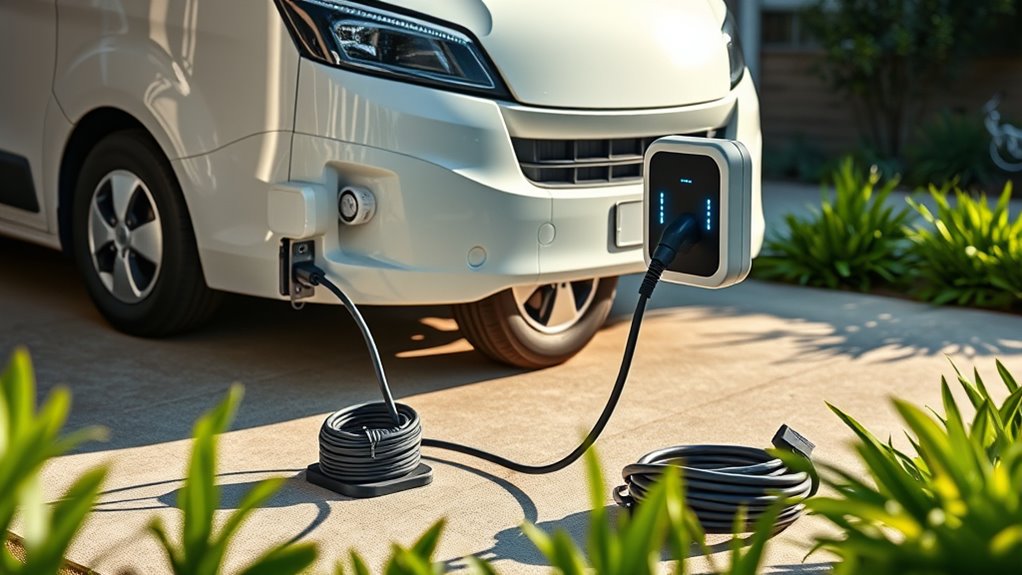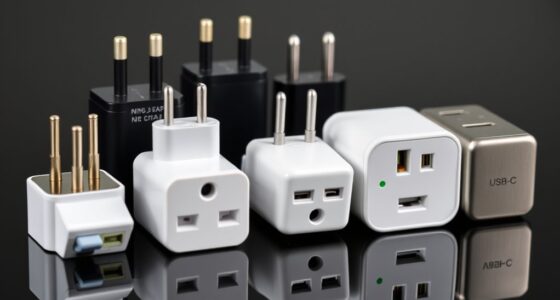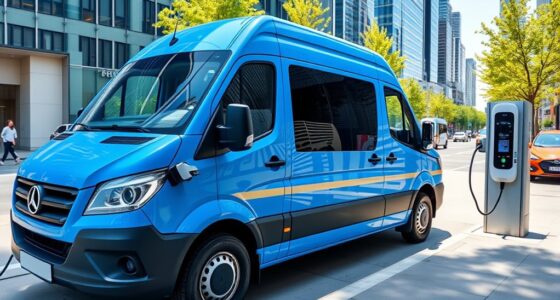To set up home charging for your E‑Transit, start by having an electrical assessment to guarantee your panel can handle a Level 2 charger’s 240-volt power demand. Choose a compatible, smart charger that fits your needs, and hire a licensed electrician to install it near your electrical panel in a safe, covered spot. Once set up, configure your charger for maximum use and perform regular maintenance. Continue exploring for tips to maximize your charging efficiency and safety.
Key Takeaways
- Assess your home’s electrical panel for compatibility and potential upgrades needed for a Level 2 charger.
- Choose a compatible Level 2 charger with features like Wi-Fi connectivity and adjustable power levels.
- Install the charger in a protected location near the electrical panel, ensuring sufficient cable length.
- Hire a licensed electrician to ensure proper, code-compliant installation and dedicated circuit breaker setup.
- Configure charging schedules and use remote monitoring to optimize energy use and maintain efficient operation.

Setting up a home charging station for your E‑Transit is a smart way to guarantee your vehicle is always ready to go. Instead of relying on public charging stations, which can be inconsistent and time-consuming, a dedicated home charger ensures your van is charged and prepared whenever you need it.
A home charging station keeps your E‑Transit ready, reliable, and hassle-free.
The process begins by evaluating your current electrical system. Check your home’s electrical panel to see if it can support a Level 2 charger, which typically requires a 240-volt outlet. If your panel is outdated or lacks the capacity, you might need an upgrade, which a licensed electrician can handle safely. Confirming your home’s wiring can handle the additional load is vital to prevent potential hazards and to maximize charging efficiency.
Next, choose the right charger for your needs. Level 2 chargers are popular among E‑Transit owners because they charge faster than standard outlets. Look for a model that’s compatible with your vehicle’s charging port and offers features like Wi-Fi connectivity for remote monitoring or adjustable power levels.
Consider the installation location carefully; a garage or covered driveway offers protection from weather and theft. Make sure the chosen spot is close enough to your electrical panel to simplify wiring and reduce installation costs. Also, think about cable length—having enough slack ensures you can park comfortably without straining the cord.
Once you’ve selected your charger, hire a professional electrician to install it. Proper installation isn’t just about plugging in a device; it involves ensuring all wiring meets electrical codes and safely connects to your home’s system. The electrician will install a dedicated circuit breaker for the charger and run the wiring from your panel to the charging location. This process guarantees safety and maximum performance.
After installation, you’ll need to configure your charger, which might involve setting charging schedules or connecting to a mobile app to monitor your vehicle’s charging status. This way, you’ll be able to start charging remotely or set times to take advantage of off-peak electricity rates.
It’s also beneficial to consider high refresh rates which can improve the overall efficiency of your charging setup, especially if you plan to use smart chargers that communicate with your home system for optimized energy use.
Finally, test your setup thoroughly before relying on it daily. Plug in your E‑Transit, check for error messages, and observe the charging process. Keep an eye on the charging speed and ensure the system operates smoothly. Regular maintenance, like inspecting the cable and connections, will help you avoid issues over time.
Setting up a home charging station takes some effort upfront, but once complete, it makes keeping your E‑Transit charged simple, convenient, and reliable. With a dedicated charger at home, you’ll always have the confidence that your vehicle is ready to support your daily work and travel needs without delay.
Frequently Asked Questions
What Is the Typical Charging Time for E-Transit at Home?
Charging your E‑Transit at home typically takes about 7 to 14 hours with a standard Level 2 charger.
If you use a faster Level 3 DC fast charger, you can recharge 80% of the battery in roughly 30 minutes to an hour.
Your actual charging time depends on your battery’s size, the charger’s power, and your vehicle’s current charge level.
Planning overnight charging often fits most daily needs.
Can I Install a Charging Station Myself or Need Professional Help?
You can try installing a charging station yourself, but don’t. While the idea of a DIY project sounds appealing, it’s best to call in a professional.
They’ll guarantee your setup is safe, compliant, and won’t turn your garage into a potential hazard.
Plus, avoiding electrical mishaps saves you time, money, and the headache of troubleshooting.
Trust experts—they know what they’re doing, and it’s worth the investment.
What Is the Estimated Cost of Installing a Home Charger?
Installing a home charger typically costs between $500 and $2,500, depending on the charger type and electrical work needed.
If you do it yourself, you’ll save on labor, but it’s vital to ensure proper installation for safety and functionality.
Hiring a professional might cost more, around $1,000 to $3,000, but guarantees a safe, code-compliant setup.
Consider your electrical system and budget when planning your installation.
Are There Any Government Incentives for Home EV Charger Installation?
Yes, there are government incentives available for installing home EV chargers. You might qualify for federal tax credits, which could cover up to 30% of your installation costs, or state and local rebates that reduce expenses further.
Check your specific location’s programs, as incentives vary. Taking advantage of these benefits can substantially lower your overall investment, making it more affordable to charge your E-Transit at home.
How Does Home Charging Affect My Vehicle’s Battery Lifespan?
Think of your battery like a vintage record album; frequent, gentle use helps preserve its quality.
Home charging, especially if you avoid high-speed chargers, can extend your battery’s lifespan by reducing stress and heat.
You should avoid constantly charging to 100% or letting the battery drain completely.
With proper care—like using recommended chargers and maintaining moderate charge levels—you’ll guarantee your E-Transit battery stays healthy longer.
Conclusion
Setting up a home charging station for your e‑Transit transforms your daily routine into a seamless experience. With the right setup, you’ll never have to worry about running out of power and can enjoy the freedom of effortless charging. It’s more than just convenience—it’s like having a superpower that keeps your vehicle ready whenever you need it. Invest in your home charger today, and watch your electric journey become smoother than you ever imagined!









